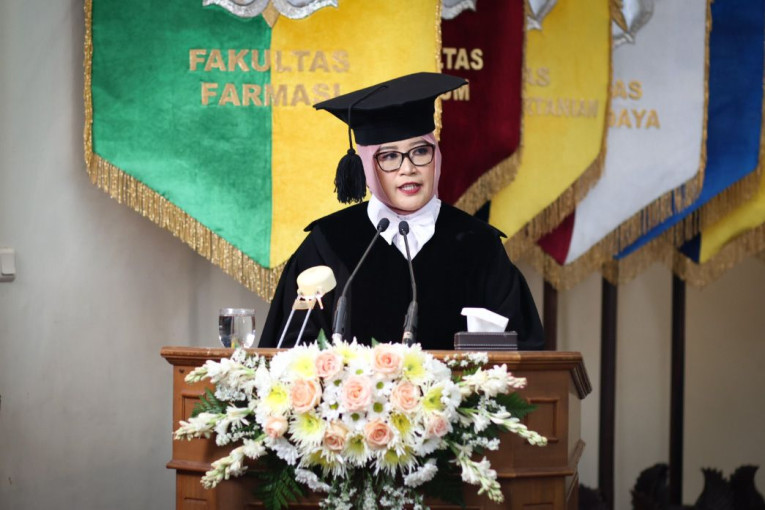
Dr. Susi Ari Kristina of the UGM Faculty of Pharmacy was officially welcomed to her position as a professor of pharmacy management and community pharmacy on Tuesday, September 26, 2023.
In her inauguration speech titled “Integration of Pharmacists in the Healthcare System Through Promotive and Preventive Roles,” she highlighted the rapid development of the pharmacist’s role.
In addition to product development and drug and vaccine distribution, pharmacists now play a much larger role in patient-oriented functions such as pharmacotherapy, prevention, and health promotion.
“Over 30,000 pharmacists work in pharmacies, with approximately 62,000 staff members in this sector. Pharmacies are the only healthcare facilities located in the midst of communities and easily accessible,” explained Professor Kristina, who was born in Pati, Central Java, on June 25, 1981.
Recognizing the significance of the pharmacist’s role, the government has included integrating pharmacists’ roles in the National Health Insurance (JKN) through three scenarios.
The first scenario involves the role of pharmacists in the referral back program (PRB). This service applies to chronic diseases such as hypertension, diabetes, heart failure, chronic obstructive pulmonary disease (COPD), stroke, asthma, epilepsy, schizophrenia, and lupus.
Pharmacies serving as PRB drug providers provide services and monitor the use of PRB participant drugs. However, according to a study conducted by Hermansyah et al. in 2020, only 9% of pharmacists in pharmacies currently participate in this program, while the rest (91%) still practice independently.
Therefore, efforts should be made to increase the coverage/number of pharmacies participating in PRB so that the main objectives of this program can be achieved more quickly.
The second scenario involves optimizing pharmaceutical service standards by pharmacists at community health centers, accommodating collaboration with all healthcare workers.
Pharmacists at community health centers can provide home visit services to improve compliance and drug therapy monitoring. However, this service is yet to be optimal due to various field constraints.
The third scenario involves pharmacists participating in the GeMa CerMat program, a rational drug use campaign program encapsulated in the slogan “DAGUSIBU.”
Community pharmacists actively participate in this program through public education in schools, community forums, or public spaces. The program’s financing is a joint effort between the Ministry of Health and provincial health offices.
Professor Kristina outlined several challenges that hinder the implementation of pharmaceutical services in primary healthcare facilities in Indonesia, which need to be identified and addressed in the future. These challenges range from the macro, meso, and micro levels.
Challenges at the macro level include legal foundations, legislation, and limitations in healthcare budget allocation within our national healthcare system. This also includes support from health authorities and investment support to ensure national drug availability.
Challenges at the meso level include the organizational culture within the community pharmacy scope, where pharmaceutical services have not kept up with evolving needs and dynamic environments.
It also entails integrating pharmaceutical information systems for management and pharmaceutical services and incorporating pharmaceutical technology into healthcare services.
The final microlevel difficulty is improving pharmacists’ expertise. Few pharmacists offer direct patient services or communication, preferring to work behind the scenes.
“Therefore, joint efforts are needed from the government as a regulator, the Indonesian Pharmacists Association as a guide, relevant stakeholders, and pharmacists to synergize and maximize the role of pharmacists in the promotive and preventive aspects,” she concluded.
Author: Ika
Photographer: Donnie

